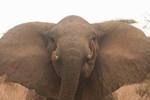
Spotted hyena in the Masai Mara. Photo by: Rhett A. Butler.
Animals of the Masai Mara is the first illustrated guidebook to the Masai Mara region along the Kenya and Tanzania border. This is the world famous region of wildebeest migrations, large felines, towering African elephants, fascinating cultures, and great flora and fauna diversity. This is the guidebook for every child, and child inside of us, between the ages of 5 and 105 that has ever dreamt of learning about the fascinating animals seen on a safari in Africa.
In the Animals of the Masai Mara, the husband and wife team of Vicki Kennedy and Adam Scott Kennedy, and their colleagues Jackson Looseyla, David Lekada Mpusia, Joseph ole Kima and Petro Naurori, have a created a wonderful guidebook. It is colorful, easy-to-use, humorous with funny, local anecdotes, and, most importantly, presented as a platform for informing effectively a wide audience about relevant scientific information regarding the region’s fauna.
The Animals of the Masai Mara showcases 65 mammals, 17 lizards, and 6 snakes species. Each animal’s entry in Animals of the Masai Mara shows their scientific name and their English, Kiswahili, and Maa names. Each entry includes key descriptive information such as physical size, gestation period, food sources, habits, and how to find them the animals.
Many guidebooks are technical and dry resulting in an inability to communicate about the iconoclastic character that draws us into the ecology where we are visiting. Yet Animals of the Masai Mara breaks this trend. It is at the same time a book that both communicates key scientific detail about each animal while it reads like a pulp novel that you buy at the airport to entertain you on a long flight.
The Animals of the Masai Mara is an enjoyable book to read. I sat down, read the book, enjoyed myself, laughed at their stories, and appreciated how their team communicates scientific information about a region that obviously the authors and commentators have great love for.
In short, this is a wonderful guide book that is a must-have for both local and international visitors to the Masai Mara region. Rich in detail, filled with quick wit, Animals of the Masai Mara is a joy to read.
How to order:
Animals of the Masai Mara
Publisher: Princeton University Press
ISBN: 978-0691156019
Authors: Vicki Kennedy and Adam Scott Kennedy
Commentary: Jackson Looseyla, David Lekada Mpusia, Joseph ole Kima and Petro Naurori
Gabriel Thoumi, CFA, Climate Bonds Initiative Advisory Panel, is also a natural resource scientist.
Related articles
Why it’s time to ban the ivory trade for good [Graphic images: viewer discretion advised]

(12/12/2012) This week the Kenya Wildlife Service (KWS) announced a 14% decline in elephants in the Samburu/Laikipia ecosystem over the last 4 years. The decline has occurred in a population whose natural growth rate was measured at 5.3% between 2002 and 2008 according to the previous survey, suggesting that over 300 elephants are dying annually in the Samburu and Laikipia’s landscape, denting the poster child image of one of Kenya’s most important wildlife landscapes. Poaching and drought are the main causes of mortality in this population. The impact of poaching on tourism cannot be ignored, heavily armed bandits threaten more than elephants, if we can’t protect elephants how can we protect international tourists? But it’s the long term consequence that are of greater concern.
Poaching in Serengeti seems worth the risk
(12/10/2012) Illegal hunting in Tanzania’s Greater Serengeti Ecosystem (GSE) remains a prevalent activity for local people, despite government regulation and grassroots movements to prevent it. A new paper from mongabay.com’s open-access Tropical Conversation Science examines the factors that drive poachers to continue their activities, despite the high costs involved. By interviewing citizens involved with illegal hunting in the Western part of the Serengeti, they were able to identify key risks that are faced by the hunters as well as the perceived gains of a successful hunt.
New inroads made into bushmeat consumption in Tanzania
(12/10/2012) Bushmeat consumption, or “wildlife hunted for human consumption,” poses a significant threat to wildlife conservation all across the globe. But in Eastern Africa—where savannah grasslands flourish and big game roam free within ‘protected’ reserves—one may be forgiven to think that poaching does not occur here: but it does.
Vanishing corridors: trying to keep big animals on the move across Tanzania

(12/10/2012) One of the biggest challenges for big African wildlife like lions, elephants, and buffalo is movement across native habitat that is increasingly being encroached on by humans. Animals find their movement restricted by roads, fences, and property boundaries which fragment the landscape. Without safe, smart, and well-maintained corridors between designated wildlife areas, animals can get cut off from resources needed for survival and from potential mates (putting genetic health at risk), even while conflicts with humans become more frequent.
Lion population falls 68 percent in 50 years

(12/04/2012) African lions, one of the most iconic species on the planet, are in rapid decline. According to a new study in Biodiversity Conservation, the African lion (Panthera leo leo) population has dropped from around 100,000 animals just fifty years ago to as few as 32,000 today. The study, which used high resolution satellite imagery to study savannah ecosystems across Africa, also found that lion habitat had plunged by 75 percent.